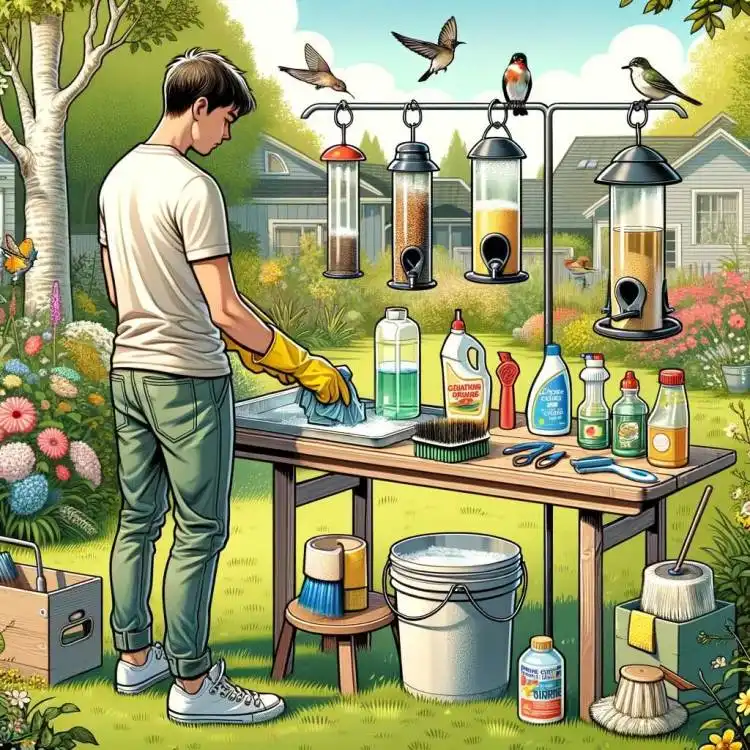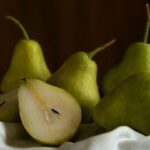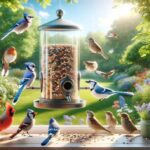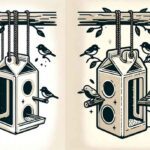Bird watching is a delightful hobby that brings us closer to nature. To ensure our feathered friends keep visiting, it’s essential to provide them with a safe and clean feeding environment. Regular cleaning and maintenance of bird feeders can prevent the spread of diseases among the bird population.
Here’s a comprehensive guide on how to clean your bird feeders and maintain hygiene, along with appropriate care during summers for those looking to delve deeper into bird feeder care.
Why Clean Your Bird Feeders?
Birds are like any other guests; they prefer a clean dining area. Feeders that are not regularly cleaned can harbor bacteria, mold, and diseases that can spread among birds. Dirty feeders can also attract pests like rodents and insects, which may lead to further contamination and the spread of diseases.
Also Read: Summer Bird Watching: The Ultimate Guide to Window Feeders
Step-by-Step Guide to Cleaning Bird Feeders

1. Gather Your Cleaning Supplies:
- A bucket or sink
- Dish soap or a bird feeder cleaning solution
- Scrub brush or toothbrush for hard-to-reach areas
- Rubber gloves to protect your hands
- Bleach or vinegar for disinfection
2. Empty the Feeder: Begin by emptying any remaining seeds or debris from the feeder. If the feeder is particularly dirty, you might want to do this outside to avoid making a mess indoors.
3. Soak and Scrub: Fill your bucket or sink with hot water and add a squirt of dish soap or a specialized bird feeder cleaning solution. Submerge the feeder in the water and let it soak for a few minutes. This will help loosen any dried-on debris. After soaking, use your scrub brush or toothbrush to clean the feeder thoroughly, paying special attention to feeding ports and other nooks where seeds can accumulate.
4. Disinfect: After scrubbing, rinse the feeder with clean water. Then, prepare a disinfecting solution by mixing one part bleach with nine parts water or using a vinegar solution (one part vinegar to nine parts water). Soak the feeder in the solution for about 10 minutes to kill any remaining bacteria or viruses.
5. Rinse and Dry: Rinse the feeder thoroughly with clean water to remove any traces of soap, bleach, or vinegar. It’s crucial to ensure the feeder is completely rinsed to prevent harming the birds. Allow the feeder to air dry completely before refilling it with seeds. Moisture can lead to mold growth, so make sure the feeder is dry to the touch.
6. Regular Maintenance: To keep your bird feeders clean and safe for birds, repeat this cleaning process at least once a month. Notably, during peak feeding times or wet seasons, consider cleaning the feeders more frequently.
Special Instructions to Clean Bird Feeders in Summer
Cleaning bird feeders in the summer requires special attention due to the higher temperatures and increased bird activity.
Here are a few additional points to consider when cleaning your bird feeders during the summer months:
1. Increase Cleaning Frequency: Summer often means more birds will visit your feeders, leading to quicker accumulation of droppings and leftover seeds that can spoil in the heat. It’s advisable to clean your feeders more frequently, ideally once every two weeks or even weekly, during periods of high use.
2. Monitor for Spoilage: High temperatures can cause seeds and nectar to spoil or ferment faster, which can be harmful to birds. Keep an eye on the seed quality, and if you notice any mold growth or foul odor, clean the feeder immediately. For hummingbird feeders, changing the nectar and cleaning the feeder every few days is crucial to prevent fermentation and bacterial growth.
3. Dry Completely Before Refilling: After cleaning, ensure that the feeders are thoroughly dry before refilling them. In summer, the higher humidity levels can prolong drying times. Moist environments are breeding grounds for mold and bacteria, so it’s essential that the feeders are completely dry to avoid these issues.
4. Use Shade to Your Advantage: If possible, position your feeders in areas that receive partial shade throughout the day. This can help keep the feed and nectar cooler, reducing the rate of spoilage and making the feeding area more comfortable for birds during the hot weather.
5. Water Hygiene: If you provide a birdbath or water feeder, summer’s heat can cause algae growth and water to stagnate more quickly. Ensure you clean these water sources regularly, changing the water every few days to provide a fresh and clean drinking source for the birds.
6. Prevent Ant Infestations: Sugar-filled nectar feeders can attract ants and other insects during the summer. Consider using ant moats, which are barriers filled with water that ants can’t cross, to keep them away from the nectar. Ensure these moats are cleaned during your regular feeder maintenance to prevent mosquito breeding.
7. Inspect for Damage: Summer storms and increased feeder activity can lead to wear and tear. During cleaning, inspect feeders for any damage or wear that could harm the birds or cause the feeder to malfunction. Replace or repair any damaged parts to ensure the safety and usability of the feeder.
By adapting your cleaning routine for the summer and being vigilant about feeder maintenance, you can help ensure a safe, hygienic, and welcoming environment for your feathered visitors during the warmest months of the year.
Recommended Products to Help You Clean Bird Feeders Effectively
- Bird Feeder Brush: A long brush designed specifically for cleaning tube feeders and reaching into crevices where seeds can accumulate.
- Sapphire Labs Feeder Fresh: An anti-microbial and moisture-absorbing product that can be added to seed feeders to prevent mold growth.
- Nature’s Way Bird Products Cleaning Solution: A natural, enzyme-based cleaning solution that’s safe for all bird feeders and effective in removing organic debris.
Also Read: How to Create a Simple Yet Effective Bird Feeder Using Everyday Materials: DIY
Wrapping up: Cleaning the Bird Feeder is Now Done
Regular cleaning and maintenance of bird feeders are crucial for the health and safety of visiting birds. By following the steps outlined above and using the right products, you can ensure that your feathered friends have a clean and safe place to dine. Not only does this practice help in the conservation of bird populations, but it also enhances your bird-watching experience. Keep your bird feeders clean, and enjoy the beauty of nature’s visitors in your backyard.
Remember, the well-being of our feathered friends is in our hands. Happy bird watching!



